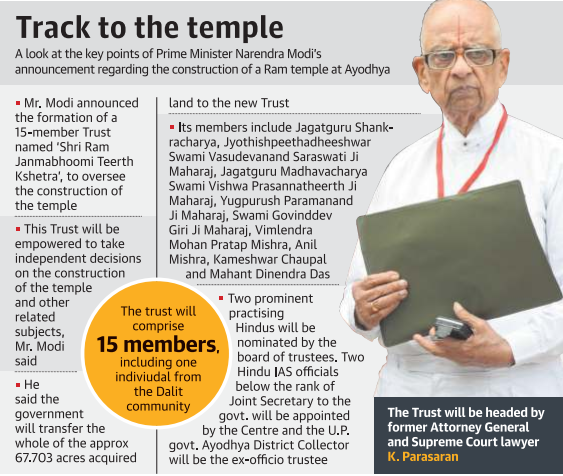Contents:
- Trust formed for Ram temple construction
- PM pitches for boost to defence exports
- Cooperative banks to come under RBI purview
- Empire of ants
- Mata Sundari Gurudwara near rouse avenue in New Delhi
- The Terracota temples of Maluti
TRUST FORMED FOR RAM TEMPLE CONSTRUCTION
Why in news?
Cabinet has approved a scheme for the construction of a grand Ram temple in Ayodhya by
setting up an autonomous trust, the Shri Ram Janmabhoomi Teertha Kshetra, to take forward the process as per the Supreme Court’s orders

PM PITCHES FOR BOOST TO DEFENCE EXPORTS
Why in news?
- India became the world’s largest arms importer as it did not utilize its capacities to full potential after Independence, Prime Minister Narendra Modi stated
- He asserted that India was looking to achieve defence exports worth ₹35,000 crore in the next five years
- A long-term integrated defence plan was being conceptualized with emphasis on startups and Micro, Medium and Small Enterprises (MSMEs). Two hundred defence startups were likely to come up to give a push to indigenisation
COOPERATIVE BANKS TO COME UNDER RBI PURVIEW
Why in news?
- The Union Cabinet approved an amendment to the Banking Regulation Act to bring multi-state cooperative banks under the watch of the central bank and prevent a repeat of Punjab and Maharashtra Cooperative Bank-like crisis
- There are 1,540 cooperative banks with a depositor base of 8.60 crore having total savings of about Rs 5 lakh crore. The proposed law seeks to enforce banking regulation guidelines of the RBI in cooperative banks, while administrative issues will still be guided by Registrar of Cooperatives
- Would be audited according to RBI rules and appointment of CEOs would require prior approval from the central bank
EMPIRE OF ANTS
- Of the 800 species in India, Bengaluru has more than 125 species with Lalbagh accounting for nearly 60
- There are 11,931 species of ants the world over, varying in size from 40 mm to 1 mm. About 25 per cent of the total insect biomass of this world is made up of ants
- Ants are a female-dominated society
- Ants make best use of available resources.
- They are now being recognised as ecological indicators like birds.
- For instance, if you see ants nesting in leaf litter, it indicates the pristine and undisturbed nature of that forest.
- Over millennia, ants have developed a close relationship with plants and animals. They pollinate and even disperse seeds
- In the tropical forests of southern India, certain species of arboreal ants build a large nest, called the Pagoda nest by chewing leaves and mixing it with secretions from their salivary glands, on trees.
MATA SUNDARI GURUDWARA NEAR ROUSE AVENUE IN NEW DELHI
- After the death of Aurangzeb, when the war of succession broke out between Prince Moazzam and Prince Azam, the former sought the help of Gobind Singh who sent a token force to help his friend at the Battle of Jajua, near Agra, in June 1707.
- But the guru camped nearby and when the need arose for reinforcements, he rushed in to Muazzam’s aid.
- Azam was fatally wounded and his elder brother ascended the throne as Shah Alam, Bahadur Shah I
- After the death of the guru and successive rulers came and went, Mata Sundari and Mata Sahib Devi were not unduly disturbed, except when the heroic Sikh warrior Banda Singh Bahadur was executed in 1716 and then in June 1725 when they had to leave Delhi and live in Mathura for two years.
- They continued to guide the panth (community) from Mata Sundari haveli, sending hukumnamas (encyclicals) to followers as far away as Kabul in the north and Dhaka in the east, rallying the Sikhs and prevailing upon them not to accept those who were trying to set up an 11th guru.
THE TERRACOTA TEMPLES OF MALUTI
- Maluti is a tiny village in Jharkhand with more than 70 exquisite terracotta temples dating back to the 17th century
- With intricate terracotta carvings of mythical scenes on their façades and walls, which have survived harsh weather and the ravages of time since the early 17th century, Maluti’s terracotta temples are now being restored.
- The temples, mostly of Shiva, are dotted in five different clusters — Sikir Taraf, Rajar Bari, Madhya Bari, Chhoi Taraf and the Mauliksha temple complex
- Situated in Dumka district, the village is close to the border with West Bengal, and Chala architecture, inspired by traditional Bengali huts with their sloping roofs with curved edges, is a distinct feature of Maluti’s temples.
- Influence of the exquisite Keshta Raya terracotta temple at Bishnupur in Bengal’s Bankura district can be seen clearly in every temple.
- The 17th century masonry technique using moulded bricks has been applied extensively.




